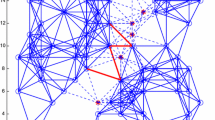Summary
In this paper we consider the problem of partitioning the set of nodes in a graph in at mostp classes, such that the sum of node weights in any class is not greater than the class capacityb, and such that the sum of edge weights, for edges connecting nodes in the same class, is maximal. This problem can be formulated as a MILP, which turns out to be completely symmetrical with respect to thep classes, and the gap between the relaxed LP solution and the optimal solution is the largest one possible. These two properties make it very difficult to solve even smaller problems. In this paper it is shown how it is possible to preassign certain nodes to certain classes, thus reducing both the symmetric nature of the formulation, the number of variables and constraints and the gap. It is also shown how the gap can be reduced even further by introducing combinatorial cuts. Computational results based on the two formulations of the problem and combinatorial cuts are presented.
Zusammenfassung
In dieser Arbeit behandeln wir das Problem der Partionierung der Knotenmenge eines Graphen in höchstensp Klassen, so daß die Summe der Knotengewichte jeder Klasse nicht größer als eine Klassenkapazitätb ist und die Summe der Kantengewichte für alle Kanten, die Knoten einer Klasse verbinden, maximal wird. Dieses Problem kann als MILP formuliert werden, es erweist sich als vollständig symmetrisch bezüglich derp Klassen, und die Lücke zwischen der Lösung der LP-Relaxation und der Optimallösung ist so groß wie möglich. Aufgrund dieser beiden Eigenschaften ist schon die Lösung kleiner Probleme schwierig. Wir zeigen in dieser Arbeit Möglichkeiten, bestimmte Knoten vorweg gewissen Klassen zuzuordnen, um damit sowohl die Symmetrie-Eigenschaft der Formulierung als auch die Anzahl der Variablen und Nebenbedingungen und damit die Lücke zu reduzieren. Weiterhin zeigen wir, wie die Lücke durch Einführung kombinatorischer Schnitte weiter reduziert werden kann. Die Ergebnisse numerischer Untersuchungen werden präsentiert.
Similar content being viewed by others
References
Balas E (1975) Facets of the knapsack polytope. Math Program 8:146–164
Christofides N, Brooker P (1976) The optimal partitioning of graphs. SIAM J Appl Math 30:55–69
Faigle U, Schrader R, Suletzki R (1986) A cutting-plane algorithm for optimal graph partitioning. Methods Oper Res 57:109–116
Lengauer T (1990) Combinatorial algorithms for integrated circuit layout. John Wiley, Chichester
Lukes JA (1975) Combinatorial solution to the partitioning of general graphs. IBM J Res Dev 19:170–180
Marsten RE (1981) The design of the XMP linear programming library. ACM Trans Math Software 7:481–497
Rendl F, Wolkowicz H (1990) A projection technique for partitioning the nodes of a graph. Report 169, Institut für Mathematik, Technische Universität Graz
Author information
Authors and Affiliations
Rights and permissions
About this article
Cite this article
Holm, S., Sørensen, M.M. The optimal graph partitioning problem. OR Spektrum 15, 1–8 (1993). https://doi.org/10.1007/BF01783411
Received:
Accepted:
Published:
Issue Date:
DOI: https://doi.org/10.1007/BF01783411




